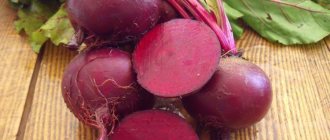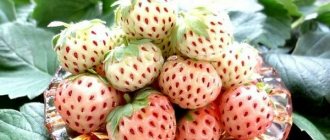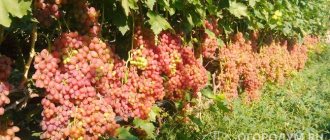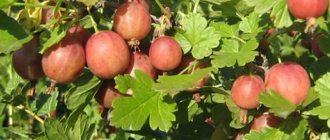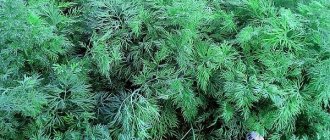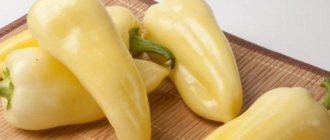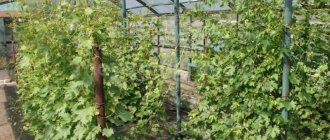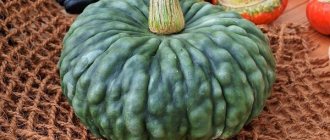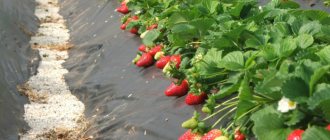Chameleon plant
The tissues of beets of any variety contain a wide variety of plant pigments (peculiar dyes). But in most varieties, this palette is “clogged” with dark red color and is not visible: in the same way, the multi-colored components of vinaigrette or borscht eventually turn into beetroot tones.
However, beets have varieties not only with burgundy or cherry roots, but also with golden, white or striped ones. There are beets that change color as they ripen from white to red. The original coloring can be not only on the roots, but also on the tops - petioles and leaves. Therefore, a bed with such varieties will look very original and elegant.
Photo: Olga Uvarova
Veins, rings or stripes - what are they and why do they appear?
| Rings | Veins | Completely white surface |
|
| Cross-pollination of table and fodder beet seeds. As a result, burgundy root vegetables turn white inside and out. |
In addition to white veins and rings, hard vascular bundles or accumulations of coarse fibers can form in the tissues of the root crop . The reason for this is also incorrect agricultural technology for growing crops.
Pure gold
This is interesting
The variety 'Burpee's Golden' was first mentioned in an English seed catalog in 1828. But scientists are sure: this yellow root vegetable, very juicy and tasty, has been grown in the Mediterranean for a long time. Yellow beet seeds are quite common in our market. They are sold under the names 'Golden Ball' or 'Golden Globe', but since these varieties are not listed in the State Register, we can assume that these are simply renamed foreign ones. One of the oldest varieties of yellow beets is 'Burpee's Golden'. Its weak point is the low germination of seeds, so it is recommended to sow them more often. The variety was called “golden” for a reason: its bright flesh literally glows, and even if this were not the case, it has earned its name for its rich composition of nutrients and excellent taste.
The 'Boldor' variety is also beautiful, with orange-colored skin and “sunny” pulp. Its yellow petioles contrast effectively with the bright green leaves. This is already an improved golden beet: the germination rate of its seeds is higher, the root crops are more even in size. The pulp is tasty, sweet, young leaves are eaten raw, steamed or fried.
'Golden Detroit' is a rather rare variety of the popular 'Detroit' variety with golden flesh and excellent taste. Unlike other varieties, its mature roots do not become coarse and do not lose juice when damaged. The leaves can be collected throughout the season and used like spinach. 'Golden Detroit' is bolt-resistant and stores well.
Photo: Olga Uvarova
Growing
The process of growing white beets is no different from growing red beets. Both species are equally susceptible to disease and have the same pests.
It is better to purchase seeds a couple of months before the start of sowing, because... In recent years, the root crop has become popular among agronomists, and by the beginning of the season there may simply not be any seeds in stores.
Important
The best soil for planting beets is black soil on which potatoes, legumes, tomatoes or herbs previously grew.
It is recommended to sprinkle the soil with lime in the fall, but this step can be skipped. Pre-fertilizing the soil will also help you get a high yield.
- They begin to sow beets in early spring, when the temperature outside is about 10 degrees and the soil has warmed up to 5-8 degrees.
- Make a hole in the previously dug soil - an ordinary stick is suitable for this, which needs to be used to make a small groove 3-5 cm deep along the entire length of the bed. Maintain a distance between rows of 30-40 cm.
- Flush the grooves with a weak solution of potassium permanganate in warm water. This will disinfect the soil and help avoid diseases in the future. Wait for the potassium permanganate to soak in before planting the seeds.
- Sow the seeds at a distance of 8-10 cm, then water the groove again and bury it, trying not to compact the soil. Beets are a moisture-loving plant; make sure that the soil in the bed with root crops is always moist.
- About 2 weeks after the seeds germinate, you need to carry out the first weeding and loosen the soil (previously it is not recommended to do this so as not to confuse the beets with weeds). Next, weed and loosen the beds regularly once a week. If you see that plants are affected by wireworms or rot, you should immediately treat them with fungicides to avoid further spread of the disease.
- To repel insects and rodents, you can sprinkle the ground with ash or plant onions or garlic next to white beets.
- When you see that the fruits have begun to form, it is recommended to fertilize the beets with urea or ammonium mixtures in a proportion of 150 ml. for 1 hectare. A month before harvesting, stop watering and applying any fertilizers.
- White beets are harvested in mid or late September. Root vegetables can be easily pulled out of dry soil by hand.
Some farmers use special methods for cultivation. These include:
- Picking . The seeds are planted in boxes and planted in the ground after reaching a certain size.
- Mulching . Sprinkling the soil with some soil (hay, ash) to prevent weeds from growing.
- Hilling up . Digging each fruit with a small amount of soil for the appearance of adventitious roots and additional loosening.
These techniques are not used everywhere, and whether to use them or not is up to you.
White clothes
By the way
One of the big advantages of white and yellow beets, which every housewife will appreciate: it does not stain your hands when cooking and does not leave stains on clothes. One of the most popular white beet varieties in Europe is 'Albina Vereduna' (sometimes sold under the names 'Albino', 'Albino White' or 'Snowhite'). In addition to the sweet “blond” root vegetable, it is also interesting for its beautiful wavy leaves. Of course, it is not suitable for borscht, but it will enrich any soup and puree with a pleasant mild taste, and is also suitable as a side dish for poultry and fish. The leaves of this variety are not only decorative, but also contain many vitamins and minerals, so they are also used as food. The 'Yellow Cylindrical' variety is also gaining popularity - its cylindrical root crop is yellow on the outside, but the flesh is white, tasty and juicy.
Varieties
There are important rules for choosing a variety:
- The packaging indicates the type of soil recommended for this variety and its resistance to weather conditions. Pay attention to this first of all.
- On the back of the bag it is written for what purpose the variety is best suited (storage or canning). It is not recommended to store beets intended for canning; they may be susceptible to rotting and fungal diseases.
- It is best to buy seeds from trusted producers. It is also worth remembering that the package should always have the inscription F1/ It means that the plant is a first generation hybrid, that is, it received all the best properties from its “parents”. Such plants are more resistant to external factors and are not susceptible to fungal diseases.
- Read the description of the fruit on the reverse side carefully. Don't rely only on the picture on the package.
- Choose beets according to the desired ripening period (early ripening, mid-ripening, late).
The most popular varieties in Russia are: “Alaska”, “Mansk”, “Belorusskaya single-seeded 69”, “Cascade”, “Sugar”, “Crystal”.
Let us present one of the varieties in detail.
Alaska
Description of the variety
Single-seeded, high-yielding hybrid of sugar beet. The root crop is oval-cone-shaped, weighing 650 g.
The aboveground and underground parts of the root crop are white. The leaves are arranged vertically. The leaf is dark green, the petiole is green. Leaves for harvesting - 40% of the total weight.
Resistant to root beetle, root rot and cercospora. Sugar beets are also grown as a fodder crop.
Agricultural technology
- Beets grow best in rich, fertile soils with a neutral reaction. On heavy soils it needs to be grown in ridges.
- In the fall, humus is applied to the beet area, if necessary, the soil is limed, and in the spring, complex mineral fertilizer is applied.
- Seeds are sown from early May to mid-June, to a depth of 2-4 cm. Planting pattern 8x25 cm. Seedlings can be grown: sowing at the end of April, planting hardened seedlings in open ground a month later.
- Further care consists of loosening, regular feeding and watering.
- Beet seeds can be sown before winter in late October - early November.
Beet surprise
The 'Chioggia' variety is very interesting. Its bright, round root vegetable has orange-red skin and shiny dark green leaves with ruby-red petioles. But inside there is an interesting alternation of red and white rings. As they ripen, the red rings expand, the white ones contract, and when cooked, the entire root turns a soft pink. The appearance matches the taste - sweet, tender and juicy. Such beets, simply boiled and cut crosswise into circles or lengthwise (in hearts), will decorate any dish.
Did you know
The Italian beet variety 'Chioggia' first grew in the gardens of the city of Chioggia, located in the southern part of the Venetian lagoon on the Adriatic Sea. Beets have been cultivated here for many centuries under conditions similar to those in which their wild ancestors grew. Photo: Olga Uvarova
Sugar beets and their beneficial properties
The historical ancestor of table, fodder and sugar beets is wild beet, common in India and the Far East. Of this triad, sugar is the “youngest” crop. Breeders developed it only at the beginning of the 19th century, although the German chemist Andreas Marggraf found out in the middle of the 18th century that sugars released from cane are also contained in beets.
Having adopted the secrets of processing beet juice, Russia established a sugar industry and became the world leader in the cultivation of sugar beets. In 2021, 51.4 million tons of the crop were produced.
Composition and calorie content
Per 100 g of product: 45 kcal, 1.5 g protein, 0.1 g fat, 9.1 g carbohydrates. The vegetable also contains 2 g of fiber and 2.5 g of dietary fiber, 86 g of water and 1 g of ash.
Of particular importance is the high content of mono- and disaccharides: glucose, galactose, arabinose, fructose.
The chemical composition of sugar beets includes:
- vitamins A, E, PP, C, group B;
- macroelements: potassium, calcium, sodium, phosphorus;
- trace elements: iodine, iron, copper, manganese, zinc;
- bioflavonoids;
- pectin;
- betaine.
Thanks to these substances, the vegetable helps increase immunity, improve digestion and metabolism. Regulates the functioning of the heart and blood vessels, promoting the production of hemoglobin and lowering cholesterol levels. Increases the number of red blood cells.
Beets contain a large number of antioxidants, which means they prevent the development of cancer. High iodine content improves thyroid function in hypothyroidism. The use of the product is included in the prevention of rickets in children.
Harm and contraindications for use
Despite the rich chemical composition and a lot of useful properties, sugar beets have contraindications and are prohibited:
- for hypotension due to the ability to significantly lower blood pressure;
- for kidney disease, gout and rheumatoid arthritis (oxalic acid contained in beets promotes the formation of oxalate stones and sand);
- for chronic diarrhea, since the vegetable has a laxative effect;
- with increased acidity in the stomach, which can be aggravated by oxalic acid, and dietary fiber additionally irritates the mucous membrane.
First of all, the recommendations concern the use of raw root vegetables and juice from them, however, boiled beets should not be abused.
What does sugar beet look like and how is it different from fodder beet?
Sugar beet is a biennial plant of the amaranth family. In the first year, an elongated root crop with hard white pulp and a basal rosette of leaves is formed. In the second year, generative organs sprout.
The root system consists of a main rod and lateral roots extending from it, reaching 50 cm in width and up to 3 m in depth. The main root consists of a head with leaves, a root collar and a succulent root.
The green mass is rich: in one rosette there are up to 50-60 green, smooth leaves with tall cuttings.
The photo shows sugar beets.
Fodder beet differs from sugar beet:
- appearance (root vegetables can be of different shapes and colors);
- shorter vegetative cycle (the difference is 30 days);
- chemical composition (it contains more protein and less carbohydrates, including sugars).
Summer joy
Multi-colored varieties are grown in exactly the same way as traditional ones. The only thing that should be noted is that they all, as a rule, have a short growing season. This is another direction of breeders of the 21st century - the breeding of summer beets (both colored and regular red ones too) - the so-called baby varieties. Their advantages are early ripening, a small volume of root crops that can be quickly cooked (long heat treatment destroys many of the beneficial substances of beets), and tender pulp, which can be consumed even raw.
Avalanche
Another variety of white beets is Avalanche. This is the result of the work of plant breeders from Holland. Root vegetables are distinguished by their universal use. Cooks put it in vegetable soups, prepare salads, and side dishes for meat and fish.
The root vegetables are small, but very juicy. The pulp has a delicate texture. The rings are visible in the section. Main characteristics of Avalanche:
- early ripening variety; technical ripening occurs after 90 days, but root crops are harvested after 103-107 days; they are left in the soil to ripen;
- the pulp is sweet; sugar level 10%;
- the weight of each root crop is no more than 150 g; 4 kg of vegetables are grown per 1 m2;
- Avalanche culture is sensitive to fertile soil; high rates are observed on Chernozems and fertile loams;
- plants show relative resistance to cercospora, but it is resistant to most viruses.
For white Avalanche beets, choose a sunny area. For the culture, a site is provided where zucchini, pumpkin, and cucumbers previously grew. The best predecessors are legumes and cereals. After the root crops, green manure, rapeseed, and cereals are planted.
The red color of beets comes from the pigment Betacyanin. It is absent in white root vegetables. The chemical composition of the pulp of vegetables is almost the same. They contain a large amount of carbohydrates and fiber. The increased level of nitrates makes them useful for the prevention of cardiovascular diseases and for improving blood microcirculation. Potassium improves the functioning of the muscular system. Calcium, phosphorus, silicon control the condition of inert tissue. White beets are just as healthy as red root vegetables.
It is necessary to restore the structure and chemical composition of the soil. After beets, the soil is depleted in potassium, magnesium, boron, and manganese. Root crops are not grown in the same area.
View this post on Instagram
Posted by Maria Zayats (@grezibagira) 6 Oct 2021 at 7:29 PDT
Is it possible to eat such a vegetable?
Such vegetables are allowed for consumption, but their taste will differ from the usual and expected taste of table beets.
If the root vegetable is white inside, it will not be possible to cook traditional red borscht; other dishes will also turn out unusual.
When the seeds of table beet and fodder beet are cross-pollinated, the resulting root crop can be eaten without risk to health. If there is a suspicion that the vegetable contains nitrates, it is recommended to boil it in salted water for 30 minutes. During this time, nitrates will pass into the water, and the beets will become “clean” and harmless.
Yield and Harvest
Sugar beets ripen for about three months; yellowed leaves and fruit appearing from the ground indicate the maturity of the vegetable and the beginning of harvesting. To harvest beets, just pull the top and the root crop will come out on its own. If the vegetable is hard to come out of the ground, wet the soil with the beets and wait a little, after this procedure, the ground will become soft and you can easily harvest. The average yield under favorable conditions is about four hundred centners per hectare. The average size of a ripe fruit should be 5-10 centimeters in diameter. After harvesting, the length of the petioles should not exceed 2 centimeters. Beets should be stored in a cool, well-ventilated area, avoiding direct sunlight on the root crop.
Production technology
The manufacturing stages include thorough cleaning of the raw materials and their filtration. Since sugar is produced exclusively in fully equipped factories, it is subject to certain requirements according to GOST. They relate mainly to the amount of foreign impurities in the finished product.
The production methods do not differ from each other depending on the choice of raw materials - the process is the same.
What is sugar made from?
- beet;
- cane;
- milk serum.
Raw materials for production are selected very carefully. One of the main stages of manufacturing is its purification from impurities and identification of defects that were previously invisible.
From beets
The technology for producing sugar from sugar beets includes many stages. Particular attention is paid to pre-cleaning and filtration. This is the most common product in Russia. Its market share exceeds other types, including cane and more exotic varieties.
How to make sugar from sugar beets:
- Purification of raw materials. In a beet washing machine, the fruit is cleaned of heavy and light impurities. This stage is not only mandatory, but also the most important.
- Slicing into chips. The beets are cut into small chips, which are most easily amenable to subsequent processing.
- Spin. The diffusion apparatus squeezes dark beet juice with 13% sugar content from the chips.
- Juice cleansing. The main stage of purification, which removes various impurities using carbon dioxide and lime. The equipment filters the juice, the output is a light yellow liquid. It is then clarified using sulfur oxide.
- Thickening. To isolate the crystals, the liquid is evaporated to the state of sugar syrup in special installations. After this, the sugar content is 60–75%.
- Crystallization of sugar. In vacuum installations, a yellow crystallized mixture with swelling is formed in a 1:1 ratio. This is called a massecuite.
- Post-processing. The massecuite goes into a centrifuge to produce higher quality sugar.
The quality of the final product depends on which beets the sugar is made from. Therefore, the sugar root crop is carefully selected before loading into production equipment. From it, in addition to the crystallized product itself, the output is molasses, pulp and filter cake.
The sugar content of molasses is 50%, but it is not further processed to increase it. It is used to produce alcohol, citric acid and animal feed. Filtration sludge is used in the manufacture of fertilizers. The pulp is used to produce feed.
From reed
Since sugar is made from cane using the same technological process as beets, there are no fundamental differences. But due to the shape of the raw material, it is somewhat easier at the stage of cleaning and grinding. The output is raw sugar, which is not used in the food industry. A refined product is made from it.
The main difference is the grinding equipment. This process involves blades, crushers and mills. In the latter, unfiltered dark juice is released from crushed cane.
The output is mass, which is fiber - bagasse. It contains only 0.7-0.8% sugar, it is used in the production of paper and building materials, as fuel in thermal power plants. Processed products: molasses and filter juice.
Raw sugar is obtained after boiling the massecuite of the first and second filtration. The size of the resulting crystals determines the quality.
Milk sugar
It is a yellow or white mixture that is formed from whey. The product is used in the industrial production of pharmaceuticals, in the food sector and for technical purposes.
For production, they prefer to use cheese whey with the highest lactose content - at least 5%.
The process of producing sugar from dairy raw materials:
- Separation of cheese whey from milk fat and casein dust. Produced by separator installations.
- Thermal denaturation of proteins, filtration. Produced in containers with a temperature of 90–95 degrees in an acidified environment. Whey protein coagulates, allowing it to be separated from the liquid. After filtering and obtaining a solution, sodium hydroxide is added to it to deoxidize it.
- Thickening. Occurs at a temperature of no more than 55 degrees in the presence of substances that extinguish foam (oleic acid, afromine). The resulting syrup is heated to 70–75 degrees, observing temperature conditions.
- Crystallization. Lasts from 15 to 35 hours with constant stirring.
- Separation of crystals from molasses, optional cleaning. The crystals are then ground into powder.
Refined sugar
This is pressed white sugar, packaged in the form of cubes. It was invented in 1843 in the Czech Republic. This is a profitable production, but large costs are required for the purchase and installation of equipment. Namely:
- press machines;
- packers;
- drying devices;
- packaging tools.
In addition, filtration and processing units must be purchased.
Manufacturing process:
- Mixing granulated sugar or raw sugar with water. Glycerin is often added for stickiness. This is a mixture for subsequent filtration.
- Processing the solution. The juice is isolated, the syrup and massecuite are concentrated. These are more thorough processes than in the case of working with beet and cane raw materials.
- Packaging of wet sugar, molding. The mixture is pressed using pressing rollers.
- Drying and packaging.
Refined sugar is pure sucrose, the impurities in which are no more than 0.1% according to modern requirements. Therefore, much attention is paid to equipping with equipment for the most thorough processing.
Brown sugar
The only difference in the stages of production of such sugar is less thorough filtration. What is brown sugar made from? Raw sugar obtained after processing sugar cane. The primary stage of processing involves thickening the rich brown syrup. It is molasses that gives sugar its color and caramel smell. Due to its properties, it is used mainly for the preparation of confectionery products.
The cost of the finished product is higher than that of white sugar due to transport costs - sugar cane does not grow in Russia.
Despite minor differences in composition, professional nutritionists believe that the unfiltered product contains undesirable impurities, and therefore is almost identical in calorie content to the regular one. That is, in large quantities it remains just as harmful to humans.
Since sugar cane does not grow in Russia, counterfeits of brown sugar can be found in stores. It is made from a refined product to which a dye is added. Real brown sugar is more expensive than regular sugar.
Sugar beet growing areas in the Russian Federation and its importance
For cultivation in the vast expanses of Russia, the conditions of the Central Black Earth region (Kursk, Lipetsk, Tambov, Voronezh, Belgorod regions) are most suitable. It accounts for half of the vegetable sown area (167.7 thousand sq. km).
About 18% of sugar beet production is concentrated in the Krasnodar region (according to expert analytical data for 2016).
Sugar beets are of great importance for industrial sugar production and also as livestock feed.
The advantage of the crop is that the vegetable is used completely, without waste:
- Alcohol, citric acid, glycerin, and yeast are produced from molasses;
- defecation is used as fertilizer for plants;
- The pulp serves as succulent feed for animals, including cattle and pigs;
- the extracted ethanol, when mixed with gasoline and diesel, becomes a form of biofuel.
